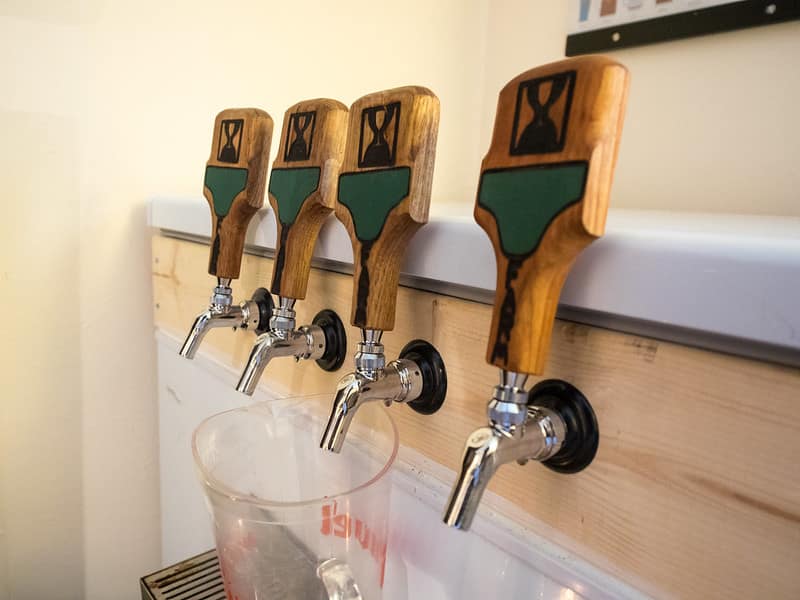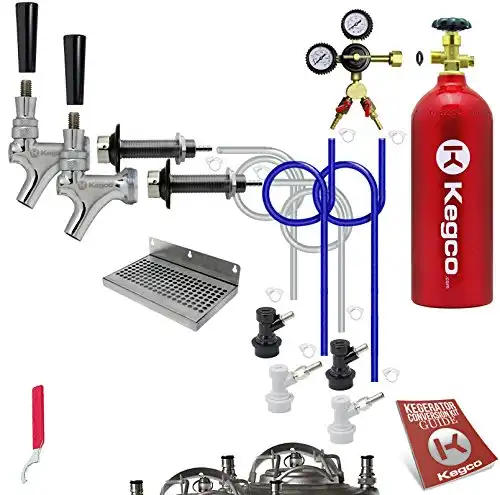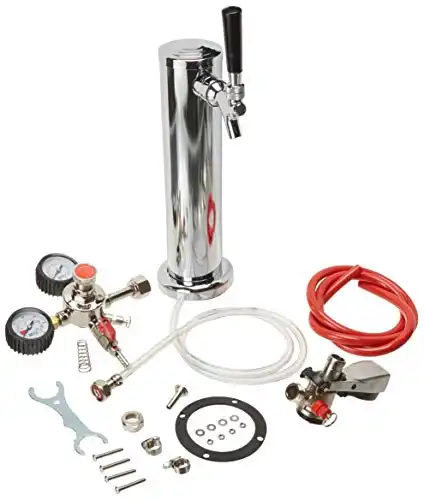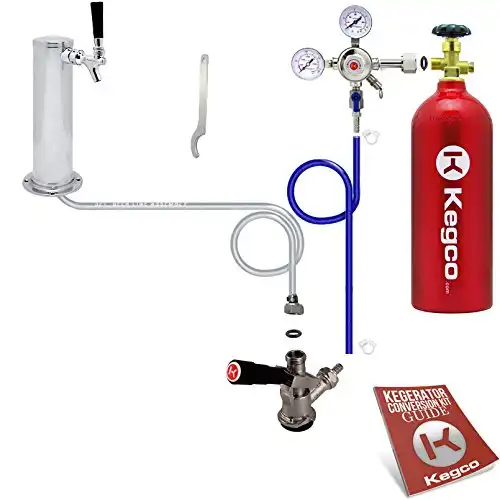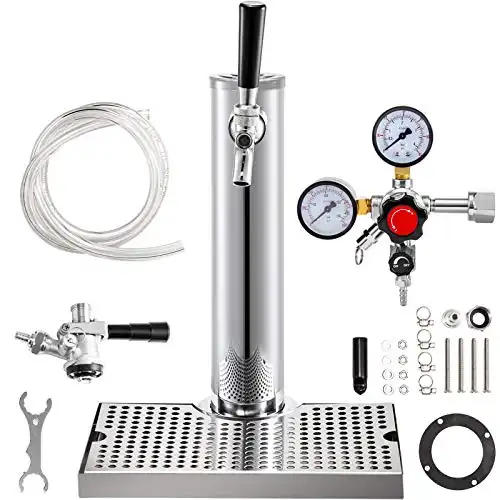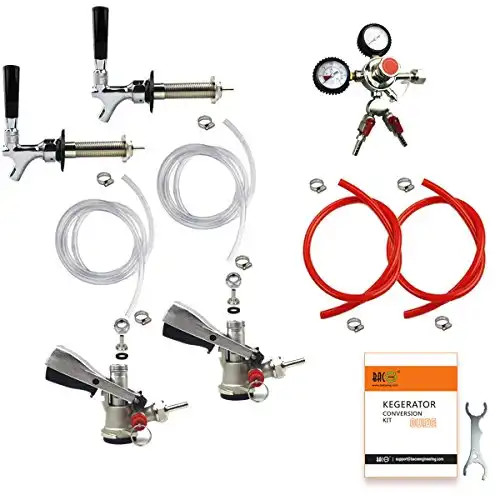For home brewers, one of the biggest questions is ultimately a short one: keezer or kegerator? It’s all well and good to brew drinks, but if you’re not ready to serve them, it’s much harder to enjoy anything you’ve made. Installing a keezer or kegerator provides on-demand access to anything you brew up.
Even if you have no interest in brewing your own beer, you might consider buying a keezer or kegerator, or building your own DIY kegerator. Bottles and cans are convenient, but nothing beats a freshly poured pint of your favorite draft beer. So here’s what you should know about your options.
What Is a Keezer?
A keezer is a low-temperature alcohol storage and dispenser system. Most keezers tend to be chest-style, putting them at roughly waist height if they’re on the ground, although some people make keezers from full-size freezer units instead. They can go to lower temperatures thanks to their existing systems, and getting a wide keezer means you can store a lot more beer.
Keezers also tend to be affordable, which makes them a good choice if you’re looking to save money while still getting a high-quality product. However, keezers tend to be quite large and can be a little noisy, so they won’t fit in every environment. Changing the kegs inside can also be challenging if you don’t have a good way to pull them out.
What Is a Kegerator?
What is a kegerator, really? At its heart, a kegerator is a beer dispenser converted from a regular refrigerator. They tend to be tall and can hold several containers of beer at once, dispensing them through the side. However, while this describes how they work, it doesn’t address the point.
A kegerator’s real purpose is keeping beer cold and fresh enough to enjoy. Kegerators are especially helpful for homebrewers because they can keep beer fresh for about two months, which is just long enough to drink through a batch and make the next.
Some people make their own, but kegerators are popular enough that it’s easy to buy one off-the-shelf and ready to install in your garage.
Keezer vs Kegerator: What’s the Difference?
The main differences between keezer and kegerator, and therefore the reasons to decide on one or the other, are their size, energy consumption, and temperature controls.
Keezer or Kegerator? Size
In terms of size, kegerators tend to be tall and narrow because they’re made from refrigerators. They may or may not include a top section that functions as an independent freezer for storing food long-term. This makes kegerators easier to fit into most garages, and for space-limited buyers, that’s a major factor.
Keezers tend to take more floor space, even though they’re not as tall. This means they can fit a lot more beer inside, but they’re bulkier and harder to deal with. Many keezers are chest-style units that open from the top, which means it’s also hard to pull your kegs in or out of them.
Neither option is big enough for a full-size beer keg. Even the largest keezers usually hold no more than a half-barrel keg, although they might have several of those side-by-side. Kegerators tend to have several sixth barrels or slim quarter kegs inside.
Keezer or Kegerator? Energy Consumption
Both kegerators and keezers use quite a lot of energy. Actual power bills will vary based on things like the efficiency of the unit, but keezers tend to use more electricity than kegerators, especially if you need to set them colder. This can lead to a big difference in the cost of running them over time.
That said, keezers tend to hold their temperature better during power outages, so there’s a lower risk of your beer warming up too much and spoiling as long as you keep it closed.
Keezer or Kegerator? Temperature Controls
Finally, there are temperature controls. Most kegerators and keezers don’t have a problem with this, but the important thing is maintaining the drink at the temperature you want. For most beers, this means somewhere between 34 and 40 degrees, although some drinks can go warmer.
That’s a normal range for any fridge or freezer, but the method of control can have a big impact on maintaining the temperature. It’s always better if you can set a specific temperature you want instead of spinning a dial and trying to guess.
Keezer Pros and Cons
Keezers have several notable advantages, including the ability to store beer for quite a long time without opening the unit. All beer will eventually go bad, but keezers can store more at once and reduce how often you need to change out your kegs or brew new drinks.
Keezers are also suitable for both residential and commercial environments, though exact regulations for using them may vary by area. The lower noise can be a nice touch, too, and they tend to be affordable if you’re buying them pre-made.
The overall design is either a positive or a negative, depending on where you plan to store the keezer. Some people stack keezers onto shelves that can pull out for replacing the kegs, which makes better use of limited space than a kegerator. Keezers can also fit under shelves much easier.
The biggest downside to a keezer, other than its shape, is the difficulty of changing the kegs. Replacing one from a traditional chest-style keezer requires pulling the entire keg vertically up, then replacing it with a container full of beer.
For those who aren’t familiar with the weight, a half-barrel of beer (the most common option for keezers) weighs about 160 pounds. That’s not easy to lift and drop into a keezer, especially if you have no assistance. A half-barrel’s weight, by itself, can be a deciding factor in whether to get a keezer or kegerator.
Kegerator Pros and Cons
Kegerators are more popular than keezers for many homeowners, and they have many appealing qualities. A standard kegerator keeps beer for about two months, and like keezers, you can use them in both personal and commercial capacities. They’re also popular enough that they’re easy to buy ready-made on the market.
Mini kegerators are also available. These only hold a mini keg’s worth of beer (about ten pints or 14 bottles), but they’re a good option if you only want to serve a little beer at a time. Most homebrewers want something bigger, though.
Kegerators are highly customizable, generally affordable, and require essentially no installation when bought ready-made aside from moving it into place. A typical kegerator doesn’t hold as much beer as a keezer, and the normally-vertical design means you’ll have to use smaller, slimmer kegs to ensure they fit.
Designs and sizes vary, but many kegerators hold two or three Cornelius kegs, which hold five gallons of beer each (about 53 12-ounce servings). Full Cornelius kegs weigh about 50 pounds, which is moderately heavy but within the range a single adult can realistically handle.
The main disadvantage of kegerators is that they tend to be noisy. This isn’t much of a problem if you’re keeping it in the garage, but if you put it indoors instead, you may have to deal with a constant hum.
How Much Does a Kegerator Cost?
Kegerator costs vary widely, especially because they come in several sizes. For example, you probably won’t need to spend much if you’re looking for mini-fridges to convert into kegerators for your kitchen, but getting a heavily-customized full-size until will run you a lot more.
A standard freestanding kegerator can cost between $600 and $3000 for the entire unit. Freestanding kegerators use normal-size refrigerators and usually have two or three faucets so you can put different drinks inside them. These are a good option for regular daily use.
Mini kegerators can cost anywhere from $50 to $500. Although they usually fit just a single miniature keg at a time, they’re a good choice for casual drinkers and anyone with particularly limited space. You can put a mini-keg almost anywhere in a house, but try to find a quiet unit so the humming doesn’t bother you.
Built-in kegerators range from $800 to $5000, making them among the most expensive options. Rather than being simple fridge conversions, built-in kegerators are permanent units that you can match to kitchen decor. Like standard units, these are ideal for daily use, as well as parties and other events.
Outdoor kegerators are rare but usually range from $1800 to $5000. To clarify, outdoor kegerators include those not put inside the house or in garages. These work well for patios and similar areas. Like built-ins, outdoor kegerators tend to be expensive. In this case, it’s because they need to be more powerful so they can keep beer cool even in summer.
Finally, commercial kegerators are the premium option for serious users. While the kegerators themselves function more-or-less identically to home units, commercial systems tend to have helpful add-ons like more storage space, extra refrigeration areas for small cans, and places to store cleaning equipment. Costs range from $600 to $5000.
Remember to account for the expected lifespan of the unit if you’re converting an existing fridge to a kegerator. If your fridge is already fifteen years old, it might be safer to buy a new unit instead of spending a few hundred to convert it, only for it to give out in a few months or years.
However, you can always build your own DIY kegerator using a kegerator conversion kit. If you’re crafty and enjoy using your hands, it really doesn’t take all that much to convert a fridge into a kegerator. Often, you can find a decent conversion kit to make things even easier.
Pick one of these top kegerator conversion kits and you will be good to go:
4.5 | 3.5 | 4.0 | 3.0 | 3.0 |
$301.77 | $149.99 | $282.66 | $104.99 | $159.99 |
How Much Does a Keezer Cost?
These kits usually come in two types: through the door or standing/tower versions. Some kits come with one faucet while others come with up to three. No matter how you want to set up your kegerator, you’ll find a kit that works for you.
A typical keezer costs $500 to $1500, depending on factors like size and whether you’re getting a conversion kit or buying the entire freezer, too. Keezer conversion kits are relatively affordable if you have a freezer handy. The price may go up if you want to heavily customize the unit, though.
On average, a keezer is more expensive than a kegerator, even if you’re converting it yourself. However, the price difference isn’t big enough to justify deciding based on that alone. It’s much more important to get a unit that’s big enough and has all the features you want, regardless of whether it’s a kegerator or a keezer.
That said, it is important to consider the overall lifespan. Good freezers tend to last longer than refrigerators, especially because you don’t open them and wear down the components as often. Realistically, a keezer could last you more than 20 years, though you may need to replace components occasionally. Thinking long-term can help you estimate the real value of a unit.
